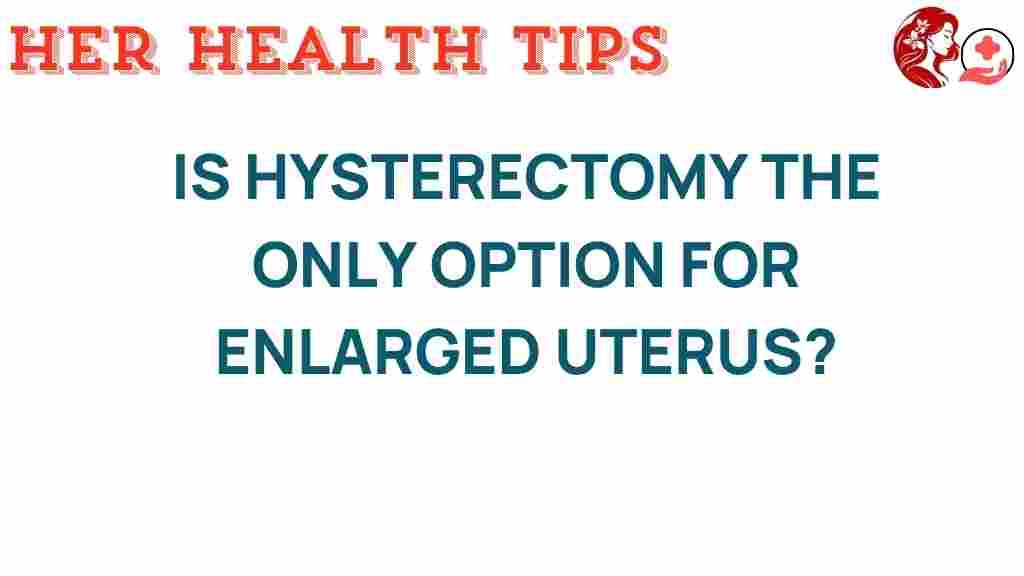Exploring Alternatives: Is Hysterectomy the Only Solution for an Enlarged Uterus?
For many women, an enlarged uterus can be a source of discomfort, leading to a range of symptoms that may affect their daily lives. While a hysterectomy is often presented as a definitive solution, it is essential to explore various treatment options that can cater to individual needs and preferences. In this article, we will delve into the implications of an enlarged uterus, the traditional approach of hysterectomy, and several medical alternatives that prioritize women’s health and pelvic health.
Understanding an Enlarged Uterus
An enlarged uterus, medically known as uterine enlargement, can occur for various reasons, including:
- Uterine fibroids
- Endometriosis
- Uterine polyps
- Pregnancy
- Hormonal changes
Symptoms may vary from mild to severe and can include:
- Pelvic pain
- Heavy menstrual bleeding
- Frequent urination
- Discomfort during intercourse
- Lower back pain
Recognizing these symptoms is the first step towards seeking appropriate gynecological care. If you suspect you have an enlarged uterus, consulting with a healthcare provider is crucial for diagnosis and treatment planning.
Hysterectomy: The Traditional Approach
A hysterectomy is a surgical procedure that involves the removal of the uterus. It is often recommended for women with severe symptoms related to an enlarged uterus, particularly when other treatment options have failed or are unsuitable. Types of hysterectomy include:
- Total hysterectomy: Removal of the uterus and cervix.
- Partial hysterectomy: Removal of the uterus while leaving the cervix intact.
- Radical hysterectomy: Removal of the uterus, cervix, surrounding tissues, and sometimes part of the vagina.
While a hysterectomy can alleviate symptoms and resolve issues related to an enlarged uterus, it is not without risks and long-term consequences, such as:
- Hormonal changes and menopausal symptoms
- Loss of fertility
- Increased risk of certain health conditions
Given these potential complications, many women are seeking less invasive alternatives to manage their symptoms and maintain their pelvic health.
Exploring Medical Alternatives
Fortunately, there are several treatment options available for women with an enlarged uterus that do not require a hysterectomy. These alternatives can help manage symptoms while preserving the uterus and overall health.
1. Medications
Hormonal therapies and pain relief medications can be effective in managing symptoms. Options may include:
- Hormonal birth control: Can help regulate menstrual cycles and reduce heavy bleeding.
- GnRH agonists: Medications that can shrink fibroids and reduce symptoms.
- Nonsteroidal anti-inflammatory drugs (NSAIDs): For pain management.
2. Uterine Fibroid Embolization (UFE)
UFE is a minimally invasive procedure that involves blocking the blood supply to fibroids, causing them to shrink. This can significantly reduce symptoms associated with an enlarged uterus.
3. Endometrial Ablation
This procedure removes or destroys the uterine lining to reduce heavy menstrual bleeding. It is suitable for women who do not wish to become pregnant afterward.
4. Myomectomy
A myomectomy is a surgical procedure specifically for removing fibroids while preserving the uterus. This option is ideal for women who want to maintain their fertility.
5. Lifestyle Modifications
Incorporating healthy lifestyle changes can also help manage symptoms:
- Regular exercise to promote overall health
- A balanced diet rich in fruits, vegetables, and whole grains
- Stress management techniques such as yoga or meditation
6. Alternative Therapies
Some women find relief through complementary therapies, including:
- Acupuncture
- Chiropractic care
- Herbal remedies (consult with a healthcare provider first)
Making Informed Patient Choices
It is vital for women to engage in open discussions with their healthcare providers about their symptoms, concerns, and treatment options. Here are some tips for making informed choices:
- Research: Understand the pros and cons of each treatment option.
- Seek second opinions: Consider consulting multiple specialists for their insights.
- Discuss your lifestyle: Talk about how each option may impact your daily life and health.
- Consider long-term effects: Evaluate how each choice aligns with your future health goals.
Troubleshooting Common Concerns
Many women have concerns when considering alternatives to hysterectomy. Here are some common issues and how to address them:
1. Fear of Ineffectiveness
Some may worry that non-surgical options will not provide adequate relief. It is essential to understand that while results can vary, many women experience significant improvement with alternative treatments.
2. Concerns About Recurrence
It’s important to discuss the likelihood of symptoms returning with your healthcare provider. Some treatments, like myomectomy, can lead to recurrence of fibroids.
3. Emotional Impact
Consider counseling or support groups if you are struggling with the emotional aspect of your diagnosis and treatment options. Being informed can alleviate anxiety and empower you in your healthcare decisions.
Conclusion
While a hysterectomy is a common solution for an enlarged uterus, it is not the only option available. With a variety of medical alternatives, women can choose treatments that better align with their health goals and lifestyle. By prioritizing open communication with healthcare providers and exploring all available treatment options, women can make informed decisions that enhance their overall well-being.
For more information on women’s health and gynecological care, visit this resource. Remember, your health choices are personal, and you deserve to find the option that feels right for you.
This article is in the category Reproductive and created by HerHealthTips Team
